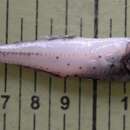Diagnostic Description
provided by Fishbase
Males with single black-bordered supracaudal gland; females with two infra-caudal luminous patches; occasional specimens with both. Luminous organs in the anal area, 5-6 anteriorly and 5-7 posteriorly, 11-13 total.
Life Cycle
provided by Fishbase
Spawns both north and south of the Polar Fronts in the eastern North Atlantic. Reported to perish after spawning (Ref. 9707).
Morphology
provided by Fishbase
Dorsal spines (total): 0; Dorsal soft rays (total): 13 - 14; Analsoft rays: 17 - 19
Trophic Strategy
provided by Fishbase
Endemic in the Mediterranean (mainly western basin) and Atlantic.
Biology
provided by Fishbase
High-oceanic, mesopelagic at depths between 375-800 m during daytime and 12-200 m during night. Depth range from 0-850 m (Ref. 4479) and from 541-1085 m in the eastern Ionian Sea (Ref. 56504). Photophores present. Feeds mainly on calanoid copepods, also euphausiids and copepodites. Feeding occurs at night in Norwegian fjords (Ref. 9209) and in northwest Africa (Ref. 9194). Mature from about 3 cm onward. Spawning peaks in the Mediterranean in late spring with east-to-west progression. Female produces 160-2,000 eggs depending on her size (Ref. 35388).
Importance
provided by Fishbase
fisheries: of potential interest

